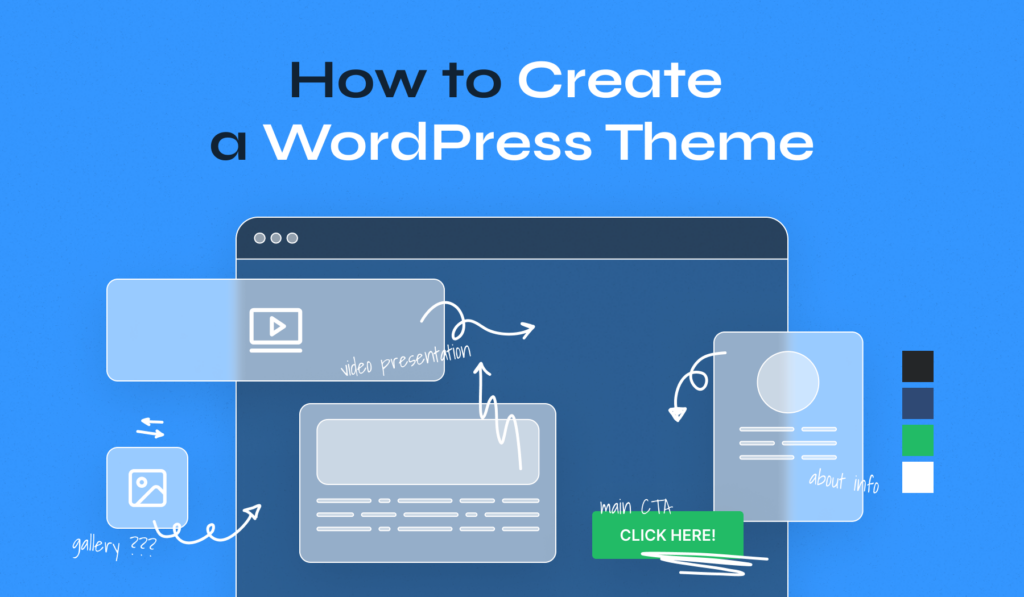Creating a custom WordPress theme from scratch might sound intimidating, but it’s a rewarding way to craft a website that’s truly your own. Whether you’re a developer looking to expand your skills or a business owner aiming for a unique online presence, this guide will walk you through the process step-by-step. By the end, you’ll know how to build a custom WordPress theme that’s fast, functional, and optimized for search engines.
In this article, you’ll learn the essentials of WordPress theme development, including setting up your environment, coding the core files, adding styles, and ensuring your theme is SEO-friendly. Let’s dive into the world of custom WordPress themes and get started!
Why Create a Custom WordPress Theme?
With thousands of pre-made themes available, why bother creating your own? A custom WordPress theme gives you full control over design, functionality, and performance. You can avoid bloated code, tailor the theme to your exact needs, and optimize it for speed and SEO—key factors for ranking well on Google in 2025.
Prerequisites for WordPress Theme Development
Before you begin, ensure you have the following:
- Basic Knowledge: Familiarity with HTML, CSS, PHP, and JavaScript.
- Local Development Environment: Tools like XAMPP, MAMP, or Local by Flywheel.
- WordPress Installation: A fresh WordPress setup on your local server.
- Text Editor: VS Code, Sublime Text, or any code editor you prefer.
Step 1: Set Up Your Theme Folder
Navigate to your WordPress installation’s wp-content/themes directory. Create a new folder for your theme, e.g., my-custom-theme. This folder will house all your theme files.
Step 2: Create the Core Theme Files
A basic WordPress theme requires at least two files:
- style.css: Defines your theme’s styles and metadata.
- index.php: The main template file.
Start with style.css. Open it in your editor and add this header:
/*
Theme Name: My Custom Theme
Theme URI: https://yourwebsite.com/my-custom-theme
Author: Your Name
Author URI: https://yourwebsite.com
Description: A custom WordPress theme built from scratch.
Version: 1.0
License: GNU General Public License v2 or later
License URI: http://www.gnu.org/licenses/gpl-2.0.html
Text Domain: my-custom-theme
*/This metadata tells WordPress about your theme. Next, create an empty index.php file. WordPress will recognize your theme once these files are in place.
Step 3: Build the Basic Structure
To make your theme functional, split index.php into reusable parts: header.php, footer.php, and optionally sidebar.php.
Create header.php
Add this code to header.php:
<!DOCTYPE html>
<html <?php language_attributes(); ?>>
<head>
<meta charset="<?php bloginfo('charset'); ?>">
<meta name="viewport" content="width=device-width, initial-scale=1.0">
<title><?php wp_title('|', true, 'right'); ?></title>
<?php wp_head(); ?>
</head>
<body <?php body_class(); ?>>
<header>
<h1><a href="<?php echo home_url(); ?>"><?php bloginfo('name'); ?></a></h1>
<p><?php bloginfo('description'); ?></p>
</header>Create index.php
Update index.php to include these parts:
<?php get_header(); ?>
<main>
<?php if (have_posts()) : while (have_posts()) : the_post(); ?>
<h2><?php the_title(); ?></h2>
<?php the_content(); ?>
<?php endwhile; endif; ?>
</main>Create footer.php
Add this to footer.php:
<footer>
<p>© <?php echo date('Y'); ?> <?php bloginfo('name'); ?></p>
</footer>
<?php wp_footer(); ?>
</body>
</html>Activate your theme in the WordPress admin under Appearance > Themes. You should see a basic layout with your site’s title and content.
Step 4: Add Styles with CSS
Enhance style.css with some basic styling below the metadata:
body {
font-family: Arial, sans-serif;
margin: 0;
padding: 0;
}
header {
background: #333;
color: #fff;
padding: 20px;
text-align: center;
}
main {
max-width: 800px;
margin: 20px auto;
padding: 0 20px;
}
footer {
background: #333;
color: #fff;
text-align: center;
padding: 10px;
}This creates a clean, responsive design. Customize it to match your vision!
Step 5: Add Functionality with functions.php
Create a functions.php file to add features like menus and widget areas:
<?php
function my_custom_theme_setup() {
// Add theme support for title tag
add_theme_support('title-tag');
// Register navigation menu
register_nav_menus(array(
'primary' => __('Primary Menu', 'my-custom-theme'),
));
// Add support for post thumbnails
add_theme_support('post-thumbnails');
}
add_action('after_setup_theme', 'my_custom_theme_setup');
// Enqueue styles
function my_custom_theme_scripts() {
wp_enqueue_style('style', get_stylesheet_uri());
}
add_action('wp_enqueue_scripts', 'my_custom_theme_scripts');Update header.php to include the menu by adding this below the header content:
<nav>
<?php wp_nav_menu(array('theme_location' => 'primary')); ?>
</nav>Step 6: Create Additional Templates
Add files like single.php (for single posts) and page.php (for pages). Copy index.php and tweak them as needed. For example, page.php might look like:
<?php get_header(); ?>
<main>
<?php if (have_posts()) : while (have_posts()) : the_post(); ?>
<h1><?php the_title(); ?></h1>
<?php the_content(); ?>
<?php endwhile; endif; ?>
</main>
<?php get_footer(); ?>Step 7: Optimize for SEO
An SEO-friendly WordPress theme is lightweight and well-structured. Here’s how to optimize:
- Use Semantic HTML: Proper tags like
<header>,<main>, and<footer>. - Minimize CSS/JS: Keep code lean to boost load times.
- Responsive Design: Add media queries in
style.css. - Schema Markup: Integrate via plugins or custom code.
Step 8: Test and Launch
Test your theme across browsers and devices. Use tools like WordPress Theme Check to ensure compatibility. Once satisfied, upload it to your live site via FTP or the WordPress admin. For more on theme testing, check the official WordPress Theme Development Handbook.
Conclusion
Building a custom WordPress theme from scratch is a powerful skill in 2025. It lets you create a unique, optimized site tailored to your needs. With HTML, CSS, PHP, and a bit of patience, you’ve now got the foundation to design standout WordPress themes. This guide has covered the essentials—from setting up your files to optimizing for SEO—so you’re ready to launch your custom creation.
Want to take your skills further? Experiment with advanced features like custom post types or Gutenberg blocks. Have questions or tips? Share them in the comments below!


